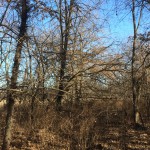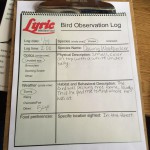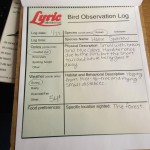Monthly Archives: January 2015
Observing Birds


 Today, I went out into the forest to observe birds. The temperature was in the lower sixties which was a great day to do this. I went out to the biggest bird feeder and sat near it for a while, still. After awhile, some birds flew down and closer as I was able to get a better look at them. I took pictures with my camera of the ones that I could get close to. When I came back, I used this “Bird Observation Log” and put what kinds of birds I saw, their description, and habitat behavior.
Today, I went out into the forest to observe birds. The temperature was in the lower sixties which was a great day to do this. I went out to the biggest bird feeder and sat near it for a while, still. After awhile, some birds flew down and closer as I was able to get a better look at them. I took pictures with my camera of the ones that I could get close to. When I came back, I used this “Bird Observation Log” and put what kinds of birds I saw, their description, and habitat behavior.
Water Quality 2015 (1)
I’m very fortunate to be able to collect data. January is a cold month which consist of the Blue River and the WSC Wetland to be froze over. After a few nice, warmer days, only the Wetland had melted just enough to get a water sample.
As it looks, with the weather being nice, the oxygen and the water has gone down along with the nitrates and phosphates. This has mad the water more clear compared to August data. I do believe if I was to collect the water at the average or below temperature during January, I would have got different numbers.
1st Grade Lesson
For the last week I’ve been observing/working with a first grade lesson that teaches them about the different types of invertebrates and vertebrates. At first, they learn about the spinal cord (backbone) and the roles it plays through out our body. Next, they figure out what time of animals are warm and cold blooded.
Then, we explain the directions to the activity they’re going to do.
Each group walks over to a specific table, which as clues as to what kind of animal it is (amphibians, birds, fish, invertebrates, mammals, and reptiles). After they’ve gathered clues from their adult, they circle what they think and then rotate to the next table.
Kindergarten Lesson
With Kindergarteners, this is there first time coming to the WCS. In order for them to have a great experience their first time, we teach them about the cutest things, animals.
The students enter and they sit in their seat. We give one-two kids a card which has a native animal of Kansas of it. The students figure out what kind of animal they are assigned and when it is their turn, they go to the front and talk about their animal. Animals that are not commonly know to kids this young are taught with having them activity move and show the characteristic of that certain animal. Once they’re done learning about the animals, we get animals skins out to everyone. Each kid find their own animals that they were assigned and sits by it. Next, they can go around and touch/observe all the animals that they’ve learned.
At the very end of the lesson, once all the furs are put away, we teach them the Habitat Song. The Habitat songs consist of a very catchy tune about certain animals living in certain habitats. Even older students who come to the WSC remember and still want to sing this song .